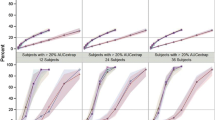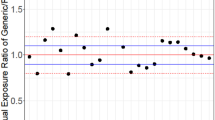Abstract
Purpose. To compare the applicability and accuracy of truncated area (AUCt; where t represents truncated time) versus area to the last quantifiable time point [AUC(O-T)] for assessing bioequivalence. Drugs with either very low or very high intra-subject variability in clearance (CL) were selected for study. Clearance variability was defined by the number of subjects with a quantifiable plasma value (Cp) at each collection time from 24 hrs to last collection time (T).
Methods. Data for amiodarone and danazol, drugs with different distributions of subject CL were examined. For amiodarone, the number of subject samples observed (test + reference) at the time of the last quantifiable concentrations was 60 at 240 hrs(T), 16 at 144 hrs and 4 at 96 hrs; while danazol had 4 at 96 hr(T), 3 at 72 hrs, 16 at 60 hrs, 7 at 48 hrs, 14 at 36 hrs, 11 at 24 hrs, 13 and 2 at 16 and 12 hrs, respectively. Simulations (Scenarios A and B) were performed to obtain populations (N = 24) with CL patterns similar to those of amiodarone and danazol. For scenario A (CL pattern similar to amiodarone), log-normally distributed CL values (28.8 L/HR) with intra-subject coefficient of variation (CV) of 25%, 40% and 60% gave the desired CL pattern. Scenario B (CL pattern similar to danazol) required that a subpopulation with an increase in CL of 40% from baseline (i.e., 40.32 L/HR) in 5%, 10% and 20% of the population represent the desired distribution. Power was evaluated by the percentage of times the simulated trials were declared bioequivalent (i.e., the number of times the test vs. reference 90% CI was within 80−125%), while accuracy was determined when the true difference in fraction absorbed (i.e., 1.25) was within the CI. Each simulation was repeated 300 times.
Results. The simulation results for Scenario A indicated that the statistical results using truncated area (AUCt) had power and accuracy equivalent to that obtained using the AUC(O-T) metric. However, results for Scenario B indicated that AUCt had less power and accuracy than that obtained using AUC(O-T). The confidence interval (CI) for amiodarone was the same whether AUC (0-T) or AUCt was used as the metric for extent, while for danazol, the AUC(O-T) and AUCt differed in the lower limit by 7%.
Conclusions. The truncated area, AUCt, has the greatest power and accuracy when the population clearance is such that most subjects have measurable plasma concentrations at last collection time(T), resulting in a proportional loss of data from each subject.
Similar content being viewed by others
REFERENCES
F. Y. Bois, T. N. Tozer, W. W. Hauck, M. L. Chen, R. R. Patnaik, and R. L. Williams. Bioequivalence: performance of several measures of rate of absorption. Pharm. Res. 11:966–974 (1994).
F. Y. Bois, T. N. Tozer, W. W. Hauck, M. L. Chen, R. R. Patnaik, and R. L. Williams. Bioequivalence: performance of several measures of extent of absorption. Pharm. Res. 11:715–722 (1994).
T. N. Tozer, F. Y. Bois, W. W. Hauck, M. L. Chen, and R. L. Williams. Absorption rate vs. exposure: which is more useful for bioequivalence testing? Pharm. Res. 13:453–456 (1996).
M. N. Martinez and A. J. Jackson. Suitability of various noninfinity area under the plasma concentration-time curve (AUC) estimates for use in bioequivalence determinations: Relationship to AUC from zero to time infinity (AUC0-INF): Investigation by simulation. J. Pharm Sci. 8:512–517 (1991).
M. L. Chen. An alternative approach for assessment of rate of absorption in bioequivalence studies. Pharm. Res. 9:1380–1385 (1992).
K. K. Midha. Retrospective evaluation of relative extent of absorption by the use of partial areas under plasma concentration versus time curves in bioequivalence studies on conventional release products. Euro. J. Pharm. Sci. 4:381–384 (1996).
S. K. Niazi, S. M. Alam, and S. I. Ahmed. Partial-area method in bioequivalence assessment: Naproxen. Biopharm. Drug Disp. 18:103–116 (1997).
L. Endrenyi and L. Tothfalusi. Truncated AUC evaluates effectively the bioequivalence of drugs with long half-lives. Int. J. Clin. Pharmacol. Ther. 4:142–150 (1997).
A. J. Romero, C. Bon, E. Johnson, S. E. Rosenbaum and C. T. Rhodes. Use and limitations of the truncated area under the curve in bioequivalence testing. Clin. Res. Pract. Drug Reg. Affairs. 8:123–151 (1990).
A. J. Jackson. Evaluation of a Cmin and a normalized Cmin method for the confirmation of steady-state in bioequivalence studies. Pharm. Rs. 15:1077–1084 (1998).
T. Fullerton, A. Forrest, and G. Levy. Pharmacodynamic analysis of sparse data from concentration-and effect-controlled clinical trials guided by a pilot study. An investigation by simulations. J. Pharm. Sci. 85:600–607 (1996).
Author information
Authors and Affiliations
Corresponding author
Rights and permissions
About this article
Cite this article
Kharidia, J., Jackson, A.J. & Ouderkirk, L.A. Use of Truncated Areas to Measure Extent of Drug Absorption in Bioequivalence Studies: Effects of Drug Absorption Rate and Elimination Rate Variability on this Metric. Pharm Res 16, 130–134 (1999). https://doi.org/10.1023/A:1018839300168
Issue Date:
DOI: https://doi.org/10.1023/A:1018839300168




